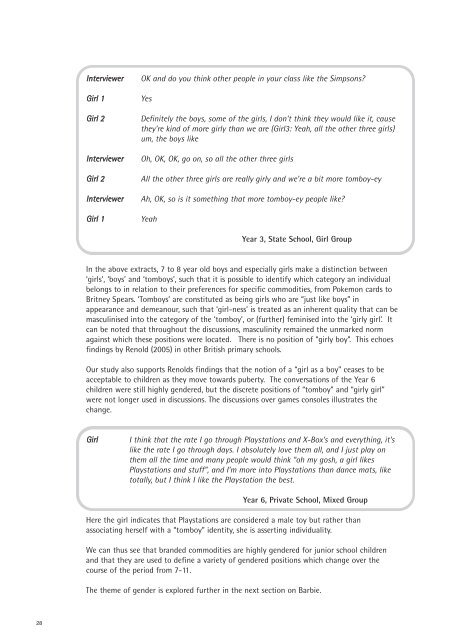The Simpsons are Cool but Barbie's a Minger - Professor Agnes Nairn
The Simpsons are Cool but Barbie's a Minger - Professor Agnes Nairn
The Simpsons are Cool but Barbie's a Minger - Professor Agnes Nairn
Create successful ePaper yourself
Turn your PDF publications into a flip-book with our unique Google optimized e-Paper software.
28<br />
Interviewer OK and do you think other people in your class like the <strong>Simpsons</strong>?<br />
Girl 1 Yes<br />
Girl 2 Definitely the boys, some of the girls, I don’t think they would like it, cause<br />
they’re kind of more girly than we <strong>are</strong> (Girl3: Yeah, all the other three girls)<br />
um, the boys like<br />
Interviewer Oh, OK, OK, go on, so all the other three girls<br />
Girl 2 All the other three girls <strong>are</strong> really girly and we’re a bit more tomboy-ey<br />
Interviewer Ah, OK, so is it something that more tomboy-ey people like?<br />
Girl 1 Yeah<br />
Year 3, State School, Girl Group<br />
In the above extracts, 7 to 8 year old boys and especially girls make a distinction between<br />
‘girls’, ‘boys’ and ‘tomboys’, such that it is possible to identify which category an individual<br />
belongs to in relation to their preferences for specific commodities, from Pokemon cards to<br />
Britney Spears. ‘Tomboys’ <strong>are</strong> constituted as being girls who <strong>are</strong> “just like boys” in<br />
appearance and demeanour, such that ‘girl-ness’ is treated as an inherent quality that can be<br />
masculinised into the category of the ‘tomboy’, or (further) feminised into the ‘girly girl’. It<br />
can be noted that throughout the discussions, masculinity remained the unmarked norm<br />
against which these positions were located. <strong>The</strong>re is no position of “girly boy”. This echoes<br />
findings by Renold (2005) in other British primary schools.<br />
Our study also supports Renolds findings that the notion of a “girl as a boy” ceases to be<br />
acceptable to children as they move towards puberty. <strong>The</strong> conversations of the Year 6<br />
children were still highly gendered, <strong>but</strong> the discrete positions of “tomboy” and “girly girl”<br />
were not longer used in discussions. <strong>The</strong> discussions over games consoles illustrates the<br />
change.<br />
Girl I think that the rate I go through Playstations and X-Box’s and everything, it’s<br />
like the rate I go through days. I absolutely love them all, and I just play on<br />
them all the time and many people would think “oh my gosh, a girl likes<br />
Playstations and stuff”, and I’m more into Playstations than dance mats, like<br />
totally, <strong>but</strong> I think I like the Playstation the best.<br />
Year 6, Private School, Mixed Group<br />
Here the girl indicates that Playstations <strong>are</strong> considered a male toy <strong>but</strong> rather than<br />
associating herself with a “tomboy” identity, she is asserting individuality.<br />
We can thus see that branded commodities <strong>are</strong> highly gendered for junior school children<br />
and that they <strong>are</strong> used to define a variety of gendered positions which change over the<br />
course of the period from 7-11.<br />
<strong>The</strong> theme of gender is explored further in the next section on Barbie.


